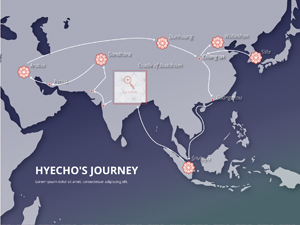
In 721, an eighteen-year-old Buddhist monk named Hyecho left his native Korea for China, beginning what would become one of the most extraordinary journeys in the history of Buddhism. From China, he sailed on a merchant ship to the kingdom of Shrivijaya on Sumatra in modern Indonesia, arriving in India in 724. Moving east to west, he visited the holy sites associated with the life (and past lives) of the Buddha, as well as other Buddhist sacred places in South Asia, crossing modern-day India, Pakistan, and Afghanistan. Where others’ pilgrimages ended, however, Hyecho’s continued west—for reasons we can only speculate, he voyaged into Persia where he encountered Islam, recording one of the earliest extant accounts of the religion by a Buddhist. He then turned eastward, traveling through Central Asia on the trade routes of the Silk Road, and stopping in the oasis town of Dunhuang around 727. It was there, in 1908, inside the famed Library Cave, that French scholar Paul Pelliot discovered a fragmentary manuscript of Hyecho’s journal—the source of almost everything we know about this young Korean monk today.
Hyecho was neither the first nor the last East Asian pilgrim, famous or anonymous, to make the voyage to India. He did not become an eminent translator or a consequential teacher upon his return to China, and is thus absent from the vast literature of Chinese Buddhism. If not for Pelliot’s recovery of his journal, Hyecho may very well have been lost to the tides of time. But what emerges from the fragmentary text is an unconventional journey that is truly remarkable among the known pilgrimages made by Buddhists over many centuries.
While Hyecho generally followed the pilgrimage route well-established by his predecessors, he wandered off this path in a variety of ways. He visited many of the traditional holy sites in India, but skipped several major ones, such as the monastic university at Nalanda. And yet, he journeyed south to Buddhist caves near Nasik and later into Persia—way off the beaten path—traveling further than any known Buddhist pilgrim. Hyecho fulfilled his intention to visit the Buddhist heartland, but did not realize the most common motivation for Chinese monks: to study and collect Sanskrit texts from Buddhism’s source.
Hyecho’s was also a remarkably quick trip through a diversity of landscapes and cultures, the observations of which he recorded in his journal more with the eye of an ethnographer than that of a Buddhist practitioner. Without knowledge of local languages, Hyecho’s encounters were reserved to observations of art and architecture, landscape and climate, people and livestock, and what can only be assumed to be information transmitted in merchant caravans and pilgrims’ rest houses.
What makes Hyecho exceptional are the many things he is not and the many things he did not do, as well as the extraordinary things he did accomplish, which offer intriguing clues into the person he was. Hyecho, his journal, and his journey, therefore, present a new perspective on and a unique experience of the Buddhist world in the eighth century.



